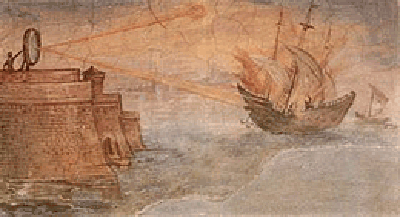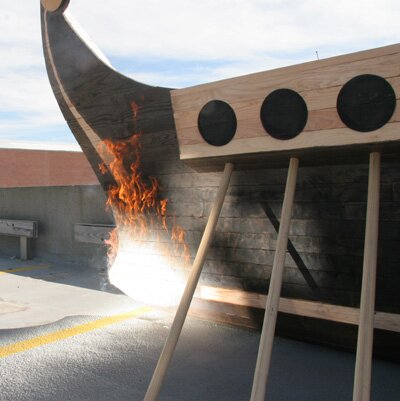Sun 9 Oct 2005


MIT via BoingBoing reports:
Ancient Greek and Roman historians recorded that during the siege of Syracuse in 212 BC, Archimedes (a notably smart person) constructed a burning glass to set the Roman warships, anchored within bow and arrow range, afire. The story has been much debated and oft dismissed as myth.
TV’s MythBusters were not able to replicate the feat and “busted” the myth.
Intrigued by the idea and an intuitive belief that it could work, MIT’s 2.009ers decided to apply the early product development ‘sketch or soft modeling’ process to the problem.
Our goal was not to make a decision on the myth—we just wanted to assess if it was at least possible, and have some fun in the process. Jumping ahead, you can see the result… but let’s start at the beginning of the process.
(btw, the boat is made of 1″ thick red oak and this is a photoshop-free zone!)
When a new idea pops into one’s head it’s good to do a quick feasibility estimate. The course instructor’s quick “back of the envelope” calculation (done while pondering the MythBuster result) indicated that it could be possible (assuming that the wood is not reflective).
When the 2.009 class was given a 5 minute challenge to assess technical feasibility, about 95% (of 80 students) deemed the death ray infeasible. In a democracy this would probably doom the idea. However, since ‘the bosses’ thought it might work, further exploration and sketch model tests to learn more were merited.
Although many of the images of the death ray depict Archimedes with a parabolic mirror, it seemed like a bunch of individual flat mirrors positioned by ‘the troops’ would be a fast, more practical implementation of the concept.
A quick test at 1 PM in the afternoon using a flat 1 square foot mirror positioned 100 feet from a target (aka tree) in Killian court gave a reflection over roughly 3-4 square feet.
If the mirrors were flat, why was this dispersion observed? If the sun was a true point source and the mirrors were perfectly flat, the size of the reflected image on the target would not change with distance. However, the sun does have some width (it occupies roughly 0.5 degrees in the sky) and this results in the dispersion that we observed.
Yes, 100 feet is a bit close for bow and arrow range, but that is the amount of space we had to work with. Using the new information, the revised estimate for the mirror area was on the order of 100 square feet. With our flat mirrors, we would need to use more of them for targets at a greater distance or, we could cup them (very slightly concave) to compensate for dispersion resulting from the sun not being a point source. In that case, the number of mirrors would not need to be increased for a more distance target.
Aiming techniques were finalized after a few more quick experiments using 20 mirrors, and then the inventory of mirrored tiles (129, 1 foot square mirrors) was purchased at a hardware store.
When a Roman ship conveniently sailed into Killian court at 1 PM on Friday, September 30, 2.009 was prepared for the ‘teamwork and coordination’ challenge.
But alas, the sun gods did not cooperate. Note the cirrostratus clouds blanketing the sky. Although the day was still bright, this type of even cloud cover diffuses the sunlight.
In addition to reducing the available power, each mirror made a very diffuse image on the ship, making aiming more difficult, as evidenced by the size of the bright spot.
Who would of thought that Archimedes had a bullhorn (or would be on the Roman ship)?
Only feeble wisps of smoke were observed.
Verdict: Inconclusive
Things learned: The idea is very sensitive to even light cloud cover; it was difficult to aim the mirrors; it is hard to get a large, unpracticed group to work together as an efficient team.
What next? The ship, slightly more than 10 feet long, appeared again Tuesday, October 4 on the roof of West Garage (a convenient, but less scenic, location… at this site the setup could be stored if the weather did not cooperate). A team of approximately 10 faculty, staff and graduate students showed up to defend.
The ship itself was planked with red oak flooring, based on the (flawed) recollection that the MythBusters used oak for their test. It is much more likely that Roman ships were planked with cedar or cypress, and only used oak to make strong keels. Since cedar and cypress are easier to ignite than oak, the oak ship was probably a more demanding, conservative test.
The Roman ships are believed to have been painted with colored wax. Ours was stained with ‘minwax’. While it was thought that these materials would help with energy absorption and possibly act as accelerants, in the end it seemed that the stain did not matter… ignition occurred evenly over an area involving both raw wood and stained wood. The stain volatiles had boiled off and the region was evenly charred well before open flame was achieved.
The mirrors were roughly positioned (but not aimed) using stands and then covered. This time there was 127 mirrors (in case you are counting, two mirrors from the first test were casualties).
At 11:45 AM, a targeting mirror was positioned to project an ‘X” onto the ship, providing an unambiguous spot on which to aim.
The aiming spot was slightly aft of the ship (to its right) since, at this distance and time of day, the ‘hot spot’ will move from right to left at a rate of approximately 36 feet per hour!
The height of the light reflected from each mirror was adjusted using a stick to prop the mirror at the necessary angle, and the horizontal location of the reflection was adjusted by rotating the ceiling tile on which the mirror was standing. After aiming a mirror, it was covered so that the projected targeting “X” remained easily visible.
Time to aim fast. Five team members worked quickly to aim each mirror at the targeting X and then cover it. This took 10 minutes, during which the targeting X traversed ~5 feet in the horizontal direction (vertical movement is very small).
Uncover the mirrors! … And there is smoke, almost immediately!
Dang, that’s hot!
But look! There are pesky clouds again. At least this time the sun gods are a bit more kind. These are cirrus clouds and an open patch of sky is coming (to the right of the sun).
Times goes by… and the cloud still covers the sun. Smoke, but no charring and we are running out of boat. The mirrors are continuously adjusted to refine the focus.
After ~20 minutes with the sun covered by cloud, we run out of boat and move the target. At least the real ships were on the order of 100 feet long!
Finally, the sun is in a clear patch of sky and the effect is dramatic.
Serious smoke.
Carbon in the wood is burning, which means the surface is at least 750 degrees F.
Note the volatiles boiling out of the end of the wood.
It’s really, really close!
Flash ignition!
In an instant there is a large, open flame. The volatiles liberated from the wood ignite at roughly 1100 F.
Open, sustaining flame occurred less than 10 minutes after the sun was in a clear patch of sky!
You can also clearly see that there are still 3 mirrors not aimed correctly.
After letting it burn for a minute, it was time to smother it and then apply water!
The short burn period created a hole through the planks.
Our 2.009 conclusion?
Feasibility estimate confirmed!
Sketch models rock!!
Questions? Try the FAQ.
Copyright © Massachusetts Institute of Technology, all rights reserved, 2005